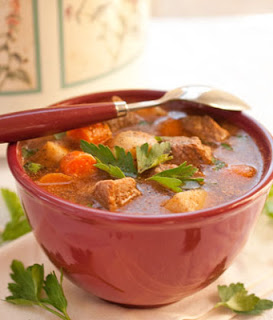 A number of notable things happened in America in the 1970s: The Watergate scandal, a funny, iconoclastic television show called “All in the Family,” (which it’s said President Nixon never found amusing), and the excessive use of the word “groovy.” Other touchstones: The widedespread wearing of ludicrous, psychedelic print bellbottoms, and a national preoccupation with a self-actualization-through-flight novel featuring a bird named Jonathan Livingston Seagull.
A number of notable things happened in America in the 1970s: The Watergate scandal, a funny, iconoclastic television show called “All in the Family,” (which it’s said President Nixon never found amusing), and the excessive use of the word “groovy.” Other touchstones: The widedespread wearing of ludicrous, psychedelic print bellbottoms, and a national preoccupation with a self-actualization-through-flight novel featuring a bird named Jonathan Livingston Seagull.
If you lived during (or is is through!) that era, or have since watched “That Seventies Show,” you’re likely aware of these phenomena. But unless you were interested in cooking; or were a kitchen appliance manufacturer; or authored cookbooks, you may have missed several other huge 1970s happenings: The arrival of the Rival Crock Pot, followed up by a blockbuster cookbook, Crockery Cookery, written by Mable Hoffman. (She was a colleague of mine who died in 2010 at 88).
in Chicago in 1971. It retailed for about $25 (comparable to a $100 + price tag today). Rival had actually obtained the original cooker, called the Beanery, from the Naxon Utilities Corporation, but repurposed the appliance to target a much broader, rapidly growing audience, women who worked away from home all day. The key selling point: Plug in a big pot of ingredients before you leave in the morning and have a hot meal waiting to serve the family when you get home at night.
The pesky little problem of disappointing dishes–slow cooker fare tended to be watery and bland if cooks tried to prepare their favorite “regular” stove-top stews and soups in the appliance–sent the first wave of consumers scrambling for recipes that would yield better results. Enter industrious home economist Mable Hoffman, whom a smallish publisher called HP Books hired on a tight deadline to cook up a cookbook to meet this demand. Trained in recipe development and food science at the University of Maryland and already
experienced at creating recipes for corporate clients, Mable, shown below left with several 1970s Crock Pots (note their Brady Bunch orange and avocado green colors), was perfect for the task.
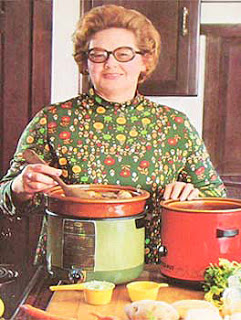 During a talk she gave at a culinary conference in the late
During a talk she gave at a culinary conference in the late
1980s, she said that to deliver the manuscript on time she’d set up twenty Crock Pots in her California kitchen and tested more or less nonstop for months. One major challenge of creating slow cooker recipes, she observed, was that, “it took a whole day to do a dish from start to finish!”
moment,” said the The Times in 1976, adding that the 20 million
Americans with slow-cookers “were eager for tips.” Eventually, Crockpot Cookery went on to sell 6 million copies, today ranking as America’s sixth best selling cookbook ever.
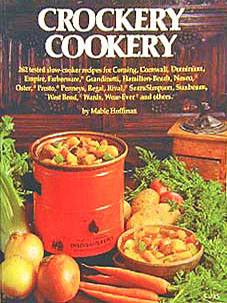 By the time I met Mable at the culinary conference she was already a legend in the cookbook business. After Crockery Cookery, she’d gone on to write a whole series of HP cookbooks, Deep Fry Cookery in 1977, Chocolate Cookery in 1978, Crepe Cookery in 1979, and, Healthy Crockery Cookery in 1985, in the process helping to turn her publisher into a major force in the industry. (Eventually, over 25 years, Mable wrote eighteen cookbooks and won several awards for excellence.) Like many other awe-struck young food writers then, I aspired to emulate Mable and write a bestseller for HP Books. No, HP never took me on, though another company did publish my first cookbook (which was not a bestseller) in 1985.
By the time I met Mable at the culinary conference she was already a legend in the cookbook business. After Crockery Cookery, she’d gone on to write a whole series of HP cookbooks, Deep Fry Cookery in 1977, Chocolate Cookery in 1978, Crepe Cookery in 1979, and, Healthy Crockery Cookery in 1985, in the process helping to turn her publisher into a major force in the industry. (Eventually, over 25 years, Mable wrote eighteen cookbooks and won several awards for excellence.) Like many other awe-struck young food writers then, I aspired to emulate Mable and write a bestseller for HP Books. No, HP never took me on, though another company did publish my first cookbook (which was not a bestseller) in 1985.
Perhaps the most remarkable thing about Mable’s incredible success was that she handled it with such grace. She was always approachable, friendly, and down to earth, and readily acknowledged that as the New York Times had suggested, the staggering sales numbers of Crockery Cookery were partly due to being in the right place at the right time “with the right thing.” During her talk she also allowed that she didn’t consider it her best book, and even agreed with detractors that slow cookers tended to make dishes taste flat.
Still, it was clear that Mable was a talented, dedicated pro who had carefully analyzed how to create appealing recipes and methodically tested them to deliver the best possible results. And, we noted, she was willing to share her expertise.
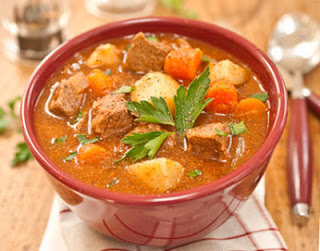
She said that one key to slow cooker recipe success was to incorporate far less liquid than was called for in traditional stove-top stews and soups and to use extra-flavorful broths and seasonings. She had figured out that the evaporation of moisture and associated concentration of flavor that normally occurs during simmering and boiling just didn’t happen in the Crock Pot, and she always took this into account. Another tip she said she’d discovered later while working on her Healthy Crockery Cookbook was to reserve some herbs or other seasoning ingredients and add them in at the very end of cooking. She felt this produced brighter, fresher tasting dishes, and I’ve found through my own recipe developing that she was absolutely right.
Nearly forty years later millions of American families are still cranking out “set it and forget it” meals in a slow-cooker, most often in a Rival Crock Pot. The model shown in the background at the top is modern, but I still have and occasionally use the vintage orange and blue striped one I bought decades ago. Frankly, I think I’m showing more wear than the pot!
Though I’ve created a number of slow-cooker recipes over the years, this one is a brand new. I wanted to head in a healthful direction with it–keeping the fat and sodium moderate and boosting the consumption of veggies, nutrients and fiber. To give the stew a bit of extra zip, I use Mable’s trick of adding in a flavor enhancer (some barbeque sauce) near the end, and garnishing the stew generously with fresh chopped parsley. (Of course, the parsley can be omitted if you wish.)
bouillon cubes or beef base and V-8 juice; do use these or the stew will be too
salty. Instead of the usual bouillon cubes, I suggest the
reduced-sodium Better Than Bouillon beef base product. The flavor is closer to
homemade beef stock, plus its paste-like consistency makes it much easier than
cubes to blend into water.
purposes. They gradually break down, which helps thicken the broth slightly.
And they contribute flavor, fiber, and extra nutrients.
into 1 1/4-inch cubes
teaspoons reduced-sodium beef base paste, dissolved in 1 cup hot water
rice, dehydrated onions, and thyme in a 3-quart or similar slow cooker. Let
stand while the remaining ingredients are readied. Stir the V-8 juice into the
slow cooker, then in the order listed add in the potatoes, carrots, celery, and
onions; do not stir further.
it heats to hot, about 45 minutes. Turn down the heat to low; cook 7 to 10
hours. Stir in the barbeque sauce; raise the heat to high and cook until the
stew is piping hot again. Garnish with fresh parsley, if desired. Makes 5 or 6
generous main-dish servings.
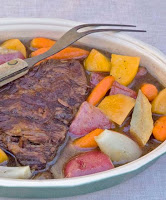 For another, totally different beef dish (with red wine) inspired by a Julia Child recipe from the same era, go here.
For another, totally different beef dish (with red wine) inspired by a Julia Child recipe from the same era, go here.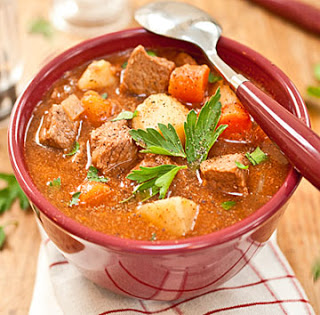
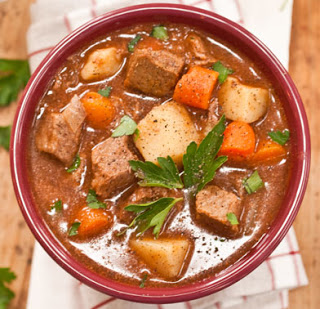

Beth, thanks for dropping by. Nice to hear that you like my blog–do spread the word!
Yes, being well trained and bright, she approached it very professionally. Getting that book out fast was very important to its success.
nancy this is a great blog. mable was a smart cookie. setting up over a dozen crockpots at once and bubbling away for testing is no small achievement…
I have the 1985 revised and updated edition of her first book. Still refer to it periodically.
Through the years, I've owned at least four crock pots. The first one was gold and did not have the removable insert. I gave that one away at least fifteen years ago. The Rival pots don't seem to wear out–they just keep on going and going. There are so many good recipes out now, but my favorite usage is cooking dried beans. Fixed a pot of navy beans this week.
Enjoyed your salute to Mabel Hoffman. Thanks for the information about her. I didn't realize that she passed away.
The worst thing I had out of the 70's color scheme was an orange sink. Certainly was a topic of conversation when we had guest.
Thanks for you comments–it certainly was a trip down memory lane for me! The wild and silly prints& styles we wore, avocado refrigerators (yes I had one), and Crock Pot recipes that often weren't very good are still vivid in my mind. Hard to believe that was so long ago…
Thanks for a great post and trip down memory lane, Nancy! Of course, I was just little…but, I remember my mom using her Rival Crock Pot. I just knew you were going to mention The Brady Bunch with those colors! Mable, standing there, reminds me of Alice on The Brady Bunch. I so appreciate reading her story, the HP cookbook publishing aspect and the history of the Rival “crock pot” or slow-cooker as we now say. Your recipe looks so yummy and healthy, too! Thanks for sharing! xo P.S. I simply adore Better Than Bouillon Beef Base and used to buy the kosher version only because it didn’t have maltodextrin (a high glycemic sugar additive) in it. But, they have since removed it…at least from their traditional variety. Not sure about the low-sodium.